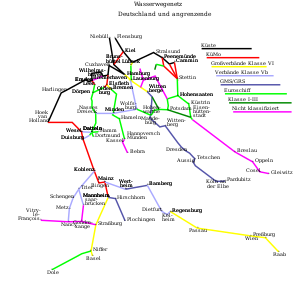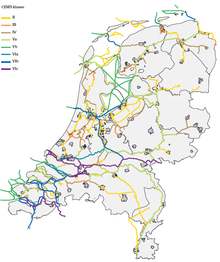Inland waterway
Inland waterways are called the waterways , i.e. navigable traffic routes, inside a land mass. This includes larger rivers and canals as well as inland lakes connected by them . As explained in the following chapter, is, inland water road 'is not synonymous with, inland nautical road'.
Inland waterway in Germany
The German inland waterways are predominantly owned by the federal government and thus federal waterways . In addition, there are state waterways in some federal states .
The following apply under shipping law :
- on the Rhine , Moselle and Danube the international regulations agreed in a shipping police ordinance,
- on the lower reaches with tributaries of the inland waterways that flow into the North Sea or Baltic Sea and on the Kiel Canal, the Maritime Traffic Regulations and the Shipping Regulations for the Ems estuary ,
- on the other inland waterways the inland waterways order .
An inland waterway can in terms of priority use and accordingly traffic rules either an internal Maritime road be or lake nautical road. Subject to the appropriate technical requirements, inland waterway vessels may also operate on sea waterways and seagoing vessels may also operate in inland waterway routes.
The so-called inland waterway # Basics of the classification CEMT classification system was introduced in the waterways and shipping administration of the federal government on March 24, 1993 by decree of the Federal Ministry of Transport for the classification of German inland waterways. Information about the possible navigability is also provided by the Inland Waterways Regulations or the ELWIS electronic waterway information system .
France
See the list of navigable rivers and canals in France
Lithuania
Waterways within the meaning of Lithuanian inland waterway law are the Nemunas and its tributaries (such as the Neris tributary ).
Poland
Poland's most important waterways are the Oder and Vistula . In the east there is a connection to the Dnieper-Bug Canal .
Austria
Waterways within the meaning of Austrian shipping law are the Danube (including the Danube Canal in Vienna) and its tributaries as well as the mouths of the March , Enns and Traun .
Netherlands
The Netherlands has an inland waterway network of around 6,200 kilometers in length, which mainly consists of canals.
Classification basics
The inland waterways are subdivided into classes according to the navigability of their fairway / fairway depending on the maximum size of the ships. The main dimensions of length and width are decisive here. Permissible discharge depths, height above the waterline and buoy information are basically variable (e.g. depending on the water level), but are given as an additional guide. The Europe-wide classification serves to promote a uniform inland waterway network. The classification system developed by a working group of the Economic Commission for Europe of the United Nations (English: Economic Commission for Europe , ECE) in 1992 has been adopted by the European Conference of Transport Ministers (CEMT, hence the name CEMT classes ).
Definition of classes
| class | length | width | Draft | Type |
|---|---|---|---|---|
| VII | 285 | 34.20 | 2.50-4.50 | 3x3 lighter |
| VI c | 280 | 22.80 | 2.50-4.50 | 3x2 lighter |
| VI c | 195 | 34.20 | 2.50-4.50 | 2x3 lighter |
| VI b | 195 | 22.80 | 2.50-4.50 | 2x2 lighter |
| VI a | 110 | 22.80 | 2.50-4.50 | 1x2 lighter |
| V b | 185 | 11.40 | 2.50-4.50 | 2x1 lighter |
| V a | 110 | 11.40 | 2.50-4.50 | Large ship on the Rhine |
| IV | 85 | 9.50 | 2.50-3.00 | European ship |
Class 0
This fictitious class is used to designate unclassified waterways that are used regularly by shipping, e.g. B. by pleasure boats or excursion boats takes place.
Classes I – III

Regional classes for smaller barge types, defined differently in detail east and west of the Elbe. Class I – III corresponds to the Péniche or the Groß-Finow- measure, BM-500 and Gustav-Koenigs-class . Applies e.g. B. for the Saar from Saarbrücken to Sarreguemines , km 91.40 - km 64.98.
Class IV (Europawasserstraße)
Every canal and river that allows so-called European ships to navigate this waterway is called a European waterway. The Europaschiff is an inland waterway vessel and has a standardized size that is valid for all European waterways. The European ship has the following dimensions: length 85 m × width 9.50 m × draft 2.50 - 3.00 m.
Class Va
Designates inland waterways that can be navigated by the so-called "Great Rhine Ship" or large motor cargo ship . The Great Rhine Ship has the dimensions: length 110 m × width 11.40 m × draft 2.50 m - 4.50 m.
Class Vb
Referred to inland waterways, of thrust associations with two barges , can be driven coupled in series. A push convoy with two barges has the following dimensions: length 172 m - 185 m × width 11.40 m × draft 2.50 - 4.50 m. This type of ship is at home on all of the aforementioned waterways except the Neckar . The Main only has Vb from its mouth to kilometer 174.20, then to 384.07 km Va, the Moselle has Vb from its mouth to the German-French border, kilometer 242.20, class Vb, the Saar from 87 km, 20 to the mouth at Conc .
Class VIa
Describes inland waterways that can be navigated by push convoys coupled with two barges side by side. A pushed convoy with two barges has the following dimensions: length 110 m × width 22.80 m × draft 2.50 m - 4.50 m
Class VIb
Like class VIa, but with four, i.e. two next to each other + two in front. The dimensions can be 195 m × width 22.80 × draft 2.50 - 4.50. These types of ships are only at home on the very large inland waterways such as the Rhine , Danube , Rhone and Waal .
Class VIc
Like class VIb, but with six barges, either 3x2 or 2x3 barges. Maximum dimensions 280 m × 22.80 m, or 195 m × 34.20 m. These combinations only operate on the Middle and Lower Rhine , from Bad Salzig to the Dutch border, depending on the water level.
Class VII
Like class VIb, but with nine barges in a formation three times three, i.e. three rows of three ships next to each other. The dimensions are length 285 m × width 34.20 m × draft 2.50 - 4.50 m.
Rivers and canals with waterway class (examples)
Rivers:
| Waters | class | from ... to |
|---|---|---|
| Danube | VI | below Regensburg |
| Danube | Vb | above to the Main-Danube Canal |
| Elbe | Va | from the Czech border to Wittenberge |
| Elbe | VIb | from Wittenberge to the Hamburg port area |
| Elbe | Va | below the Hamburg port area |
| Fulda | 0 | between Kassel and Hann. Münden |
| Lahn | 0 | between Wetzlar and the estuary |
| Main | Vb | in the lower part |
| Main | Va | in the upper part |
| Moselle | Vb | to the French border |
| Rhine | VIb | Basel to Bad Salzig (km 564.3) |
| Rhine | VIc | from Bad Salzig to the Dutch border |
| Weser | VIb | below Bremen |
| Weser | IV | above Bremen |
Channels:
| Waters | class | from ... to |
|---|---|---|
| Dortmund-Ems Canal | IV | (partial expansion to Vb is ongoing) |
| Dortmund-Ems Canal | Vb | Port of Dortmund section - junction of the Wesel-Datteln Canal |
| Elbe Lateral Canal | Vb | |
| Main-Danube Canal | Vb | |
| Mittelland Canal | Vb | west of the Elbe Lateral Canal |
| Mittelland Canal | IV | east of the Elbe Lateral Canal (expansion to Vb in progress) |
| Kiel Canal | VIb | |
| Wesel-Datteln Canal | Vb |
See also
Web links
- Information on inland waterways in ELWIS
- List of federal inland waterways serving general traffic according to (to Section 1 (1) No. 1 and Section 5 and Section 2 (2)) of the Federal Waterways Act (WaStrG).
- Federal waterway map (A4 format, 545 KByte; PDF file)
- Digital federal waterway map on a scale of 1: 1,000,000 with the structure of the Federal Waterways and Shipping Administration
- Digital federal waterway map on a scale of 1: 1,000,000 with the structure of the Federal Waterways and Shipping Administration (format 835.7 mm × 1189 mm, 7.5 MByte; PDF file)
- Resolution of the European Conference of Transport Ministers 1992 on classification (PDF file; 93 kB)
- The network of inland waterways in Europe and its parameters unece.org
Individual evidence
-
↑ Breakdown of federal waterways:
- Quote: Most of the inland waterways of both categories are also inland waterways. Inland waterways are maritime waterways if, like the lower reaches of the Warnow, Trave, Elbe, Weser and Ems as well as the Kiel Canal, they are mainly used for shipping. Seagoing ships also use inland waterways in so-called inland-sea traffic - insofar as their design allows this. Conversely, inland waterway vessels that meet certain requirements are allowed to travel on sea waterways.
- List of those inland waterways on which the Sea Waterways Regulations apply







